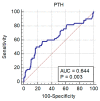Plasma Levels of Intact Parathyroid Hormone and Congestion Burden in Heart Failure: Clinical Correlations and Prognostic Role
- PMID: 36286286
- PMCID: PMC9604445
- DOI: 10.3390/jcdd9100334
Plasma Levels of Intact Parathyroid Hormone and Congestion Burden in Heart Failure: Clinical Correlations and Prognostic Role
Abstract
Circulating parathyroid hormone (PTH) concentrations increase in heart failure (HF) and are related to disease severity. The relationship between PTH and congestion is still a matter of debate. The objective of this analysis was to evaluate the role of PTH as a marker of congestion and prognosis in HF. We enrolled 228 patients with HF. Intact PTH concentrations and HYDRA score (constituted by: B-type natriuretic peptide, blood urea nitrogen−creatinine ratio, estimated plasma volume status, and hydration status) were evaluated. The study endpoint was all-cause mortality. PTH levels were higher in acute compared with chronic HF and in patients with clinical signs of congestion (i.e., peripheral oedema and orthopnea). PTH concentrations significantly correlated with NYHA class and HYDRA score. At multivariate analysis of HYDRA score, estimated glomerular filtration rate (eGFR), and corrected serum calcium were independently determinants of PTH variability. Fifty patients (22%) died after a median follow-up of 408 days (interquartile range: 283−573). Using univariate Cox regression analysis, PTH concentrations were associated with mortality (hazard ratio [HR]: 1.003, optimal cut-off: >249 pg/mL—area under-the-curve = 0.64). Using multivariate Cox regression analysis, PTH was no longer associated with death, whereas HYDRA score, left ventricular ejection fraction, and eGFR acted as independent predictors for mortality (HR: 1.96, 0.97, and 0.98, respectively). Our study demonstrated that intact PTH was related to clinical and subclinical markers of congestion. However, intact PTH did not act as an independent determinant of all-cause death in HF patients.
Keywords: BIVA; BNP; HYDRA score; PTH; congestion; heart failure; prognosis.
Conflict of interest statement
The authors declare no conflict of interest.
Figures




References
-
- Tomaschitz A., Ritz E., Pieske B., Rus-Machan J., Kienreich K., Verheyen N., Gaksch M., Grübler M., Fahrleitner-Pammer A., Mrak P., et al. Aldosterone and parathyroid hormone interactions as mediators of metabolic and cardiovascular disease. Metabolism. 2014;63:20–31. doi: 10.1016/j.metabol.2013.08.016. - DOI - PubMed
-
- Bosworth C., Sachs M.C., Duprez D., Hoofnagle A.N., Ix J.H., Jacobs D.R., Jr., Peralta C.A., Siscovick D.S., Kestenbaum B., de Boer I.H. Parathyroid hormone and arterial dysfunction in the multi-ethnic study of atherosclerosis. Clin. Endocrinol. 2013;79:429–436. doi: 10.1111/cen.12163. - DOI - PMC - PubMed
LinkOut - more resources
Full Text Sources
Research Materials
Miscellaneous

